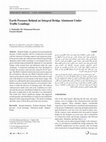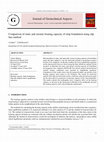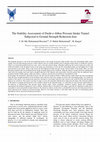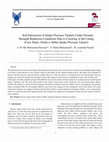Papers by S. Majdeddin Mir Mohammad Hosseini

One of the most important factors in optimized design of non-yielding retaining walls like baseme... more One of the most important factors in optimized design of non-yielding retaining walls like basement walls and bridge abutments is to determine the exact variation of earth pressure acting on such walls. In this paper, the distribution of at rest earth pressure behind a laboratory model of a fixed and rigid retaining wall with a cohesionless dry backfill is measured under the effect of static and repeated loads. The same conditions of the experimental model are then simulated numerically with a two-dimensional finite-difference analysis computer code. For the purpose of model verification, the results of numerical model are compared to the results of the experimental model, which is similar in geometrical and geomechanical properties. Cyclic surcharges with different amplitudes and frequencies are applied in different distances from the wall, and the earth pressure distribution, the resultant force, and its point of application are investigated. The effect of soil and loading parameters on the at rest earth pressure is also evaluated, and a parametric study has been carried out. The results of model show a significant increase in the earth pressure due to cyclic loading compared to static loading, especially in the initial cycles of loading. It indicates that the effect of cycling nature of loading should be essentially taken into account in the design of retaining walls.

Integral bridges are gaining increased popularity because of both economic and fast construction ... more Integral bridges are gaining increased popularity because of both economic and fast construction associated with the omission of bearing supports and expansion joints. In the present study, the earth pressure behind integral bridge abutments under traffic surcharges is investigated and compared with that induced behind the abutment of conventional bridges (with isolated deck and abutment) under the same surcharges. A numerical modeling has been developed to evaluate the dynamic earth pressure using the FLAC package. The Mohr-Coulomb criterion has been used to represent the soil behavior. Because the Mohr-Coulomb model is an elastic-perfect plastic model, the results of this study are valid only if the behavior of soil remains in the elastic ranges. The model was calibrated by direct measurement of earth pressure behind a physical model developed in soil mechanics laboratory to study the behavior of retaining walls. The induced earth pressures under static and cyclic conditions are evaluated and the pressure distribution behind the wall as well as the point of application of the total thrust was determined. The results have shown significant changes that happened in both quantity and distribution of earth pressure behind the abutment when using integral bridges. The details of findings and their causes will be discussed in the next sections.

Determination of static and especially seismic bearing capacity of foundation using slip lines me... more Determination of static and especially seismic bearing capacity of foundation using slip lines method is one the interested method in geotechnics project because of its simplicity. In slip lines method, the stress equilibrium equations on the characteristic lines are solved using the finite difference method. In this research, to determine the static and seismic bearing capacity of foundation two programs were codded in MATLAB. For seismic analysis horizontal and vertical seismic coefficient were inserted in equilibrium equations. Comparison of the results shows that the proposed model can predicts close bearing capacity with respect to the literature. The results of sensitivity analysis show that the horizontal seismic coefficient and internal friction angle are the most effective parameters on bearing capacity of the strip foundation. The results indicate that earthquakes have a negative effect on the bearing capacity, so increase in the horizontal coefficient of the earthquake decrease the bearing capacity of the strip foundation significantly.

Seismic site effect has been a major issue in the field of earthquake engineering due to the larg... more Seismic site effect has been a major issue in the field of earthquake engineering due to the large local amplification of the seismic motion. This paper presents the importance of an appropriate soil behavior model to simulate earthquake site response and gives an overview of the field of site response analysis. Some of the well-known site response analysis methods are discussed. The objective of this paper is to investigate the influences of nonlinearity on the site response analysis by means of a more precise numerical model. In this respect, site responses of four different types of one-layered soil deposit, based on various shear wave velocities with the assumption of linear and rigid base bedrock, were analyzed by using the equivalent linear and fully nonlinear approaches. Nonlinear analyses' results were compared with those of the linear method, and both of the similarities and differences are discussed. It is concluded that in the case of nonlinearity of soil under strong ground motions, 1-D equivalent linear modeling overestimates the amplification patterns in terms of absolute amplification level, and cannot correctly account for resonant frequencies and hysteric soil behavior. Therefore, more practical and appropriate numerical techniques for ground response analysis should be surveyed.
Many studies have focused on the effects of earthquake loading on the forces and displacements of... more Many studies have focused on the effects of earthquake loading on the forces and displacements of underground structures. As part of the analysis of these forces and displacements, seismic loading effects are considered when designing underground structures, and so the equations are measured under small strains. Thus, the real results in surrounding tunnels and underground structures cannot be expressed by applying these equations when large strains due to some phenomena such as liquefaction occur. In other words, the mechanism of underground structure seismic behavior has not been fully recognized, and despite the presence of several studies that have been conducted already, many others are still needed. So the present study strives to assess the effect of liquefaction on shield tunnels.
BIOSCIENCES BIOTECHNOLOGY RESEARCH ASIA,, 2014
In the present paper, discrete element method (DEM) is used to study wave propagation phenomenon ... more In the present paper, discrete element method (DEM) is used to study wave propagation phenomenon in granular soils. The effect of factors such as coefficient of friction, frequency, normal stiffness and soil gradation on the wave speed is studied. Using the wall motion based on the sinusoidal function is the method of loading used in this simulation, through which the pressure wave is transferred to particles. Simulations results are well consistent with the results of experiments conducted by other researchers. In addition, the results obtained are shown as graphs to study the effectiveness of each parameter. According to the results, the coefficient of friction and normal stiffness have a greater effect on the wave speed.

Arab J Geosc, 2010
Seismic site effect has been a major issue in the field of earthquake engineering due to the larg... more Seismic site effect has been a major issue in the field of earthquake engineering due to the large local amplification of the seismic motion. This paper presents the importance of an appropriate soil behavior model to simulate earthquake site response and gives an overview of the field of site response analysis. Some of the well-known site response analysis methods are discussed. The objective of this paper is to investigate the influences of nonlinearity on the site response analysis by means of a more precise numerical model. In this respect, site responses of four different types of one-layered soil deposit, based on various shear wave velocities with the assumption of linear and rigid base bedrock, were analyzed by using the equivalent linear and fully nonlinear approaches. Nonlinear analyses' results were compared with those of the linear method, and both of the similarities and differences are discussed. It is concluded that in the case of nonlinearity of soil under strong ground motions, 1-D equivalent linear modeling overestimates the amplification patterns in terms of absolute amplification level, and cannot correctly account for resonant frequencies and hysteric soil behavior. Therefore, more practical and appropriate numerical techniques for ground response analysis should be surveyed.

WORLD ACADEMY OF SCIENCE, ENGINEERING AND TECHNOLOGY, 2010
The induced cracks on the concrete lining of the intake pressure tunnels may cause the water seep... more The induced cracks on the concrete lining of the intake pressure tunnels may cause the water seep into the surrounding media leading to develop a hydro pressure on the external surface of the lining. In the common design practice, the lining can be designed to tolerate with this pressure using the Schleiss method. However, when the tunnel is constructed above the underground water, the seepage may cause the strength of the ground to reduce the amount of which may be considerable in some water sensible soils.
In this paper, the finite element package of PLAXIS has been used to do the non-linear analysis of an intake pressure tunnel located inside a mudstone soil. The stress-strain model for the lining is taken linear elastic and for the soil is the elasto-plastic Mohre-Columb. The analysis is carried out by developing a 2D numerical model for an area of 100X73 meters. Consequently, the optimum lining is designed while the soil strength reduction occurs due to the seepage of water through the cracks in the lining. The results of numerical analysis are compared with that obtained from Schleiss common method of designing. Finally, a series of parametric studies are carried out and some important points and comments are suggested for designing of intake pressure tunnels facing the same condition.

JOURNAL OF STRUCTURAL ENGINEERING AND GEOTECHNICS, 2011
In this paper, the hydrostatic interaction between soil and concrete lining of Dasht-e-Abbas pres... more In this paper, the hydrostatic interaction between soil and concrete lining of Dasht-e-Abbas pressure intake tunnel has been investigated when the shear strength parameters of the mudstone layers decrease due to the seepage of water to the surrounding media. To evaluate the stability of the tunnel, a two dimensional numerical simulation is developed using the finite element code called PLAXIS and interaction analyses are carried out. The analyses are done in stages to assess the maximum internal forces induced in the lining. The structural stability of the tunnel is evaluated and discussed in this condition. Based on the obtained results, it is noted that for more realistic understanding of the behavior of infrastructures like pressure intake tunnels under various conditions, numerical analyses should also accompany experimental and analytical approaches such as Schleiss method which is described in this paper, especially for tunneling in media that is susceptible to water and ground strength reduction. The numerical analysis results show a considerable increase in the lining internal forces when subjected to the reduction of ground strength. However, the tunnel structure is still stable under the effect of surrounding ground degradation with the constructed lining specifications. Abstract The hydraulic pressure is one of the most important factors in the design of pressure intake tunnels. Since the surrounding media cannot usually resist the high internal pressure of these tunnels, they are usually finished with an adequate lining mostly of reinforced concrete, which is an interaction problem between water, soil or rock and concrete lining. Although reinforcing the concrete lining may reduce the width and number of the developed cracks in the lining, the penetration of water into the surrounding media can still happen due to high water pressure in the tunnel. Thus, it may lead to the development of hydro pressure on the external surface of the lining. There are some theoretical methods that are developed for the design of tunnel lining in this condition. When the tunnel is located above the underground water table, the seeping water may lead to strength reduction of the adjacent soils, particularly when the ground, like the mudstone layers existing in Dasht-e-Abbas region, southwest of Iran, is cohesive and consists of soils that are susceptible to water.
paper by S. Majdeddin Mir Mohammad Hosseini

JOURNAL OF STRUCTURAL ENGINEERING AND GEOTECHNICS, 2013
The induced cracks on the concrete lining of the intake pressure tunnels may cause the water seep... more The induced cracks on the concrete lining of the intake pressure tunnels may cause the water seep into the surrounding media leading to develop a hydro pressure on the external surface of the lining. In the common design practice, the lining can be designed to tolerate with this pressure using the Schleiss method. However, when the tunnel is constructed above the underground water, the seepage may cause the strength of the ground to reduce the amount of which may be considerable in some water sensible soils. In this paper, the finite element package of PLAXIS has been used to do the non-linear analysis of an intake pressure tunnel located inside a mudstone soil. The stress-strain model for the lining is taken linear elastic and for the soil is the elasto-plastic Mohre-Columb. The analysis is carried out by developing a 2D numerical model for an area of 100X73 meters. Consequently, the optimum lining is designed while the soil strength reduction occurs due to the seepage of water through the cracks in the lining. The results of numerical analysis are compared with that obtained from Schleiss common method of designing. Finally, a series of parametric studies are carried out and some important points and comments are suggested for designing of intake pressure tunnels facing the same condition.






Uploads
Papers by S. Majdeddin Mir Mohammad Hosseini
In this paper, the finite element package of PLAXIS has been used to do the non-linear analysis of an intake pressure tunnel located inside a mudstone soil. The stress-strain model for the lining is taken linear elastic and for the soil is the elasto-plastic Mohre-Columb. The analysis is carried out by developing a 2D numerical model for an area of 100X73 meters. Consequently, the optimum lining is designed while the soil strength reduction occurs due to the seepage of water through the cracks in the lining. The results of numerical analysis are compared with that obtained from Schleiss common method of designing. Finally, a series of parametric studies are carried out and some important points and comments are suggested for designing of intake pressure tunnels facing the same condition.
paper by S. Majdeddin Mir Mohammad Hosseini
In this paper, the finite element package of PLAXIS has been used to do the non-linear analysis of an intake pressure tunnel located inside a mudstone soil. The stress-strain model for the lining is taken linear elastic and for the soil is the elasto-plastic Mohre-Columb. The analysis is carried out by developing a 2D numerical model for an area of 100X73 meters. Consequently, the optimum lining is designed while the soil strength reduction occurs due to the seepage of water through the cracks in the lining. The results of numerical analysis are compared with that obtained from Schleiss common method of designing. Finally, a series of parametric studies are carried out and some important points and comments are suggested for designing of intake pressure tunnels facing the same condition.